Screening and High-Throughput
Multiwell plates are the gold standard for high-throughput screening (HTS) and high content screening (HCS) in cell culture. The ibidi µ-Plates provide essential features that make them ideal for HTS/HCS when using high-resolution microscopy and fluorescence-based imaging:
- Compatible with robotics and plate readers due to an ANSI/SLAS (SBS) standard format (85.5 x 127.5 mm)
- Available with a #1.5 ibidi Polymer Coverslip bottom with extremely low autofluorescence for undisturbed fluorescence microscopy and ibiTreat (tissue culture-treated) surface for optimal cell attachment
- Available with a #1.5H Glass Coverslip bottom with highest optical quality for special microscopic applications (e.g., TIRF, super-resolution microscopy)
- Compatible with solvents for staining and fixation, as well as immersion oil
- Excellent inner well and whole plate flatness
HTS Application Examples for ibidi µ-Plates
- Compound toxicology screenings and drug screenings
- Large-scale transfection experiments
- Large-scale fluorescence microscopy
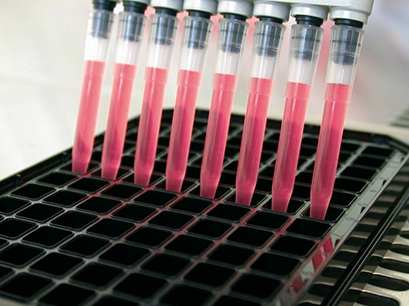
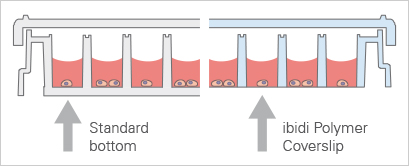
Standard 96 Well Plate With a 1 mm thick bottom made of polystyrene, not suited for high-resolution or fluorescence microscopy. | ibidi µ-Plate 96 Well With a flat ibidi Polymer Coverslip #1.5 bottom (180 µm, +10/–5 µm), ideal for high-resolution or fluorescence microscopy. |
ibidi Blog Article |
Check out the ibidi Blog article High-Content Screening: From Microscopy to Medicine to learn more about the diverse applications of High-Content Screening.
ibidi SolutionsThe µ-Plate 24 Well is a microtiter plate with black walls and 24 round wells that have a flat, clear bottom. It is suitable for versatile cell-based assays, such as wound healing experiments. |
|
We offer microtiter plates with black square or round wells and a flat, clear bottom. They are available with a #1.5 ibidi Polymer Coverslip (µ-Plate 96 Well Square and µ-Plate 96 Well Round) or a #1.5H Glass Coverslip bottom (µ-Plate 96 Well Square Glass Bottom , µ-Plate 96 Well Round Glass Bottom, and µ-Plate 384 Well Glass Bottom). The black walls guarantee a low well-to-well crosstalk, which makes the µ-Plate ideal for fluorescence microscopy. |
|
Large-Scale Live Cell Imaging Solutions
Live cell imaging is the time-lapse microscopy of dynamic processes in living cells. Several imaging techniques can be applied, such as phase contrast microscopy or confocal microscopy. During the whole live cell imaging experiment, the cells need to be kept alive and healthy. Therefore, physiological conditions have to be established and maintained on the microscope.
ibidi offers Stage Top Incubation Systems for high-throughput live cell imaging using microplates that have an ANSI/SLAS (SBS) standard format.
Find Out More
Please find more detailed information about the planning, conduction, and data analysis of live cell imaging assays in the "Live Cell Imaging" application chapter.
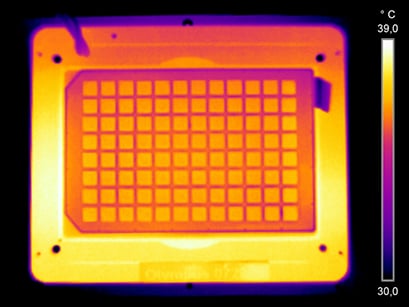
Stable and consistent temperature distribution in every well of multiwell plates in the ibidi Stage Top Incubation System. Images were acquired with a FLIR thermal camera.
ibidi SolutionsThe ibidi Stage Top Incubation Systems allow for easy live cell imaging on every inverted microscope, providing precise control of temperature, humidity, and CO2 (optionally O2). They are compatible with all inverted microscopes that have a K-Frame stage (160 mm x 110 mm) or a Nikon Ti-S-E and Ti-S-ER Motorized Stage. |
|
High-Throughput Wound Healing Assays
Wound healing and migration assays are widely used approaches for the analysis of cell migration under different conditions (e.g., when performing drug screenings).
With the Culture-Inserts, ibidi offers a solution for reproducible large-scale wound healing and migration experiments, requiring only a few steps from sample preparation to image analysis:
- Cells are seeded in the single wells, where they attach
- Removal of the silicone insert results in two precisely defined cell patches, which are separated by a 500 µm gap
- Wound closure can now be monitored by using live cell imaging or by taking photos at different time points
Find Out More
Please find more detailed information about the planning, conduction, and data analysis of wound healing and migration assays in the "Wound Healing and Migration" application chapter.
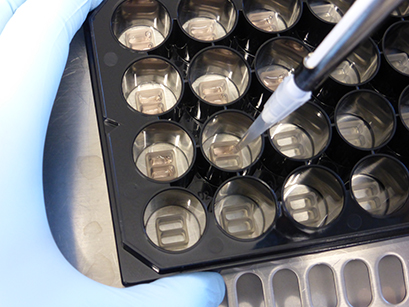

ibidi SolutionsThe ready-to-use Culture-Insert 2 Well 24 is ideal for reproducible high-throughput wound healing and migration assays. It consists of silicone Culture-Inserts with a defined cell-free gap that are already inserted into the µ-Plate 24 Well. Find a PDF of the detailed protocol for performing a wound healing assay using the Culture-Insert 2 Well 24 in the ibidi Application Note "Wound Healing Assay with the Culture-Insert 2 Well 24" (AN 36). |
|
High-Throughput Tube Formation Assays
Tube formation assays are a widely used in vitro tool for accessing angiogenesis in an easy, cost-effective, and reproducible manner. A tube formation assay is performed by first seeding single cells, and then observing and imaging the tube formation over time. From this, several readouts can be analyzed over time, such as tube length and the number of loops.
With the µ-Plate 96 Well 3D, ibidi offers a solution for tube formation experiments with only a few steps from sample preparation to image analysis. Due to the “well-in-a-well” technology, the amount of gel needed is reduced to only 10 μl per well. In addition, no meniscus is formed, ensuring the formation of a uniformly thick gel matrix.
For scientists who need only a small number of samples, ibidi also offers the µ-Slide 15 Well 3D with 15 wells.
Find Out More
Please find more detailed information about the planning, conduction, and data analysis of angiogenesis assays in the "Angiogenesis" application chapter.
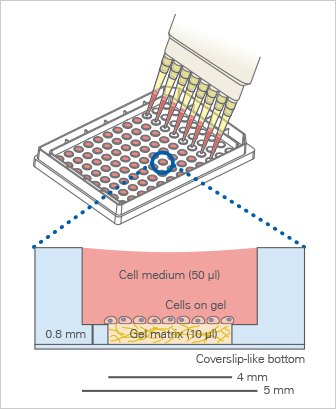
ibidi SolutionsThe µ-Plate 96 Well 3D is a multiwell plate with full ANSI/SLAS (SBS) and robotics compatibility. Due to the well-in-a-well principle, it is ideal for cost-effective tube formation experiments, requiring only 10 µl of gel per well. In addition, it allows for brilliant cell visualization without meniscus formation. Find practical advice on how to run tube formation assays using the µ-Plate Angiogenesis 96 Well in the ibidi Application Note “Tube Formation in µ-Plate 96 Well 3D” (AN 05) as a PDF. |
|




